Medigood Telehealth: Business Analysis & IS Development, S1 2018
VerifiedAdded on 2023/06/12
|21
|3385
|190
Report
AI Summary
This report details the development of an information system for Medigood, aiming to enhance treatment efficiency and reduce doctors' workload. The Waterfall model is employed for system development, focusing on patient interaction with hardware for accurate diagnostics. The analysis covers work breakdown structure, 'to-be' activity diagrams, organizational change management, screen designs, acceptance criteria based on ISO standards, and application architecture. It also compares Agile and Waterfall methodologies, recommending an in-house development team or Agile for external teams to align with Medigood's business needs and adapt to requirement changes. The report concludes with a client summary, emphasizing the benefits of the new system for remote patient diagnostics and unified business processes.
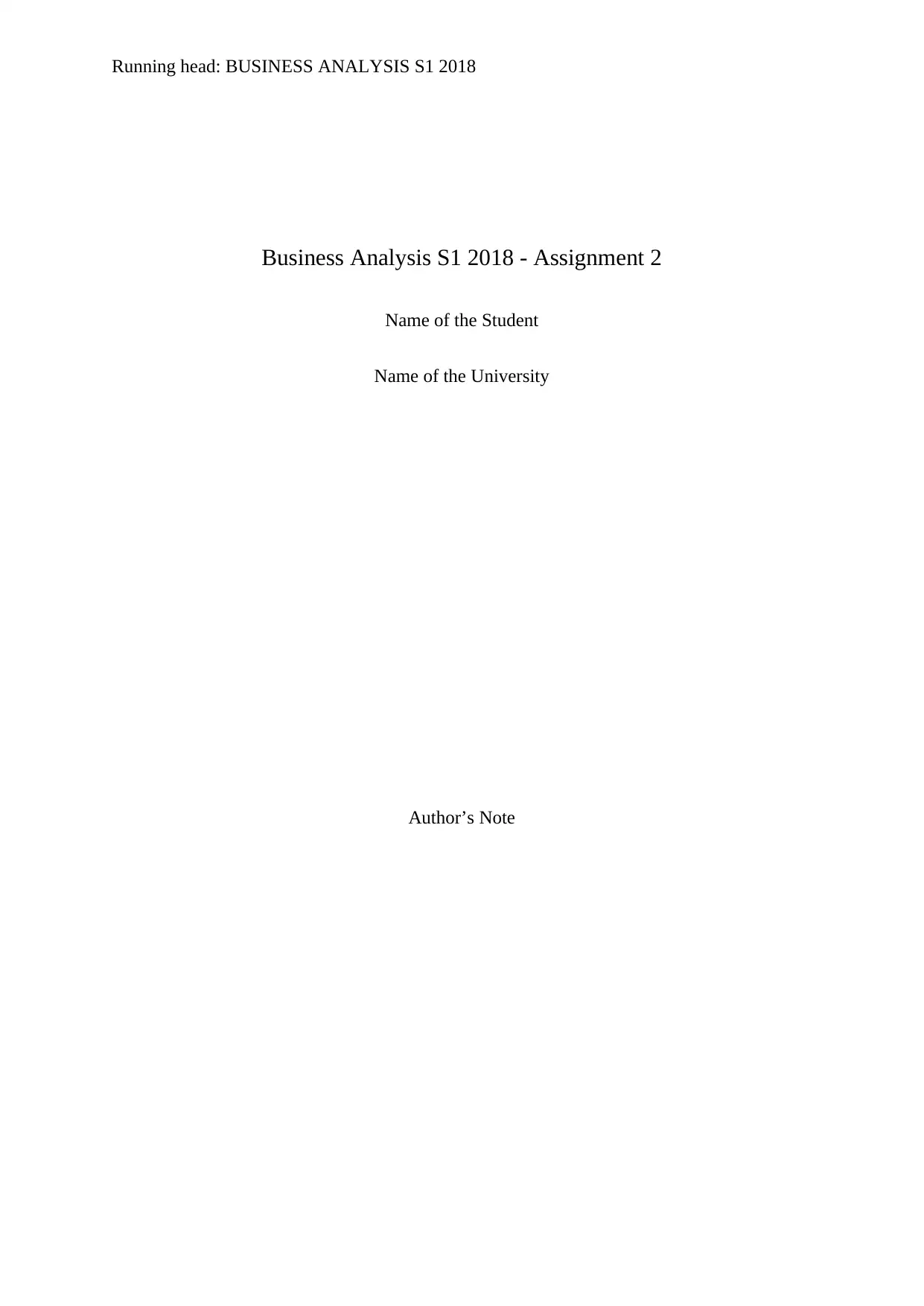
Running head: BUSINESS ANALYSIS S1 2018
Business Analysis S1 2018 - Assignment 2
Name of the Student
Name of the University
Author’s Note
Business Analysis S1 2018 - Assignment 2
Name of the Student
Name of the University
Author’s Note
Paraphrase This Document
Need a fresh take? Get an instant paraphrase of this document with our AI Paraphraser
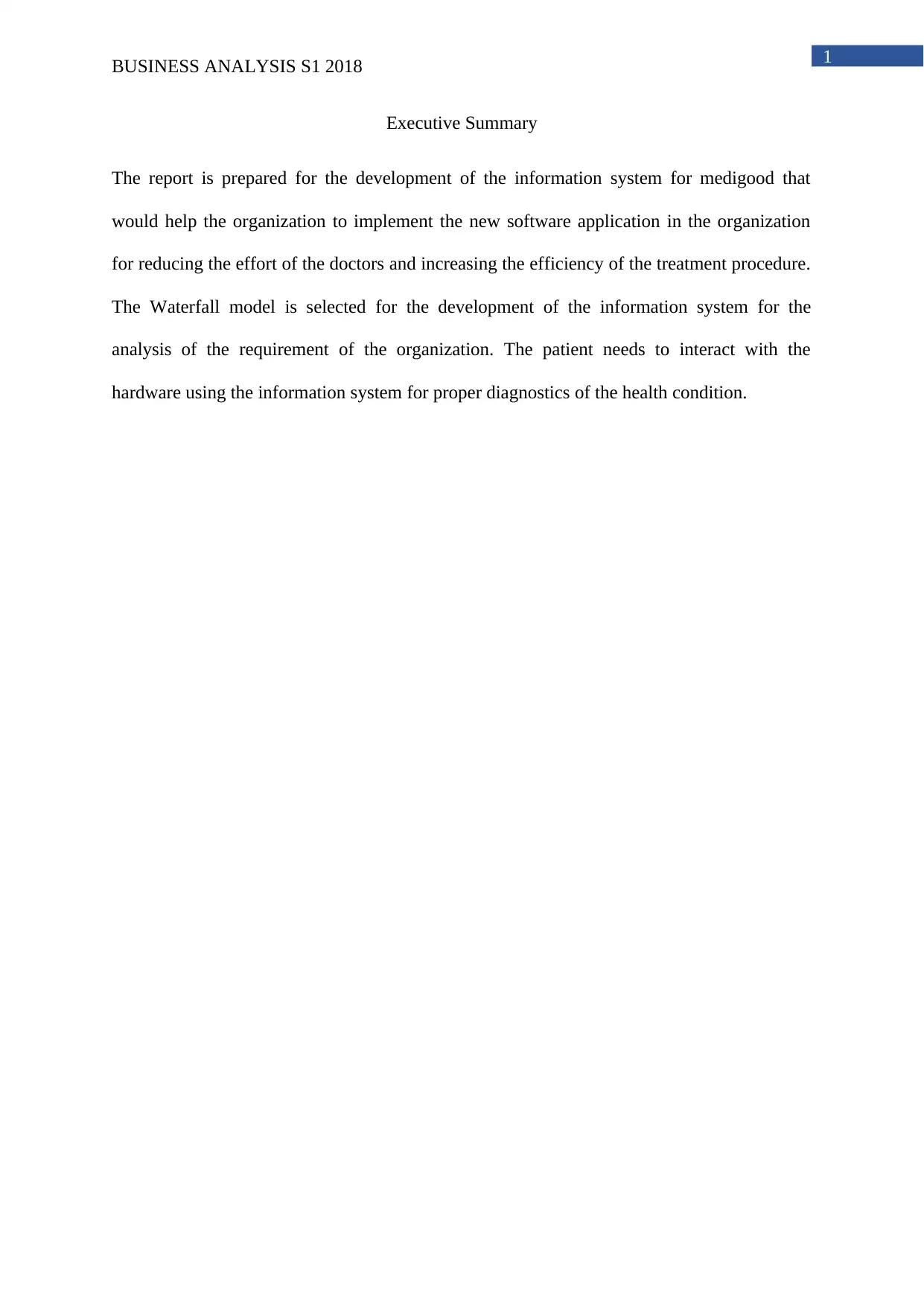
1
BUSINESS ANALYSIS S1 2018
Executive Summary
The report is prepared for the development of the information system for medigood that
would help the organization to implement the new software application in the organization
for reducing the effort of the doctors and increasing the efficiency of the treatment procedure.
The Waterfall model is selected for the development of the information system for the
analysis of the requirement of the organization. The patient needs to interact with the
hardware using the information system for proper diagnostics of the health condition.
BUSINESS ANALYSIS S1 2018
Executive Summary
The report is prepared for the development of the information system for medigood that
would help the organization to implement the new software application in the organization
for reducing the effort of the doctors and increasing the efficiency of the treatment procedure.
The Waterfall model is selected for the development of the information system for the
analysis of the requirement of the organization. The patient needs to interact with the
hardware using the information system for proper diagnostics of the health condition.
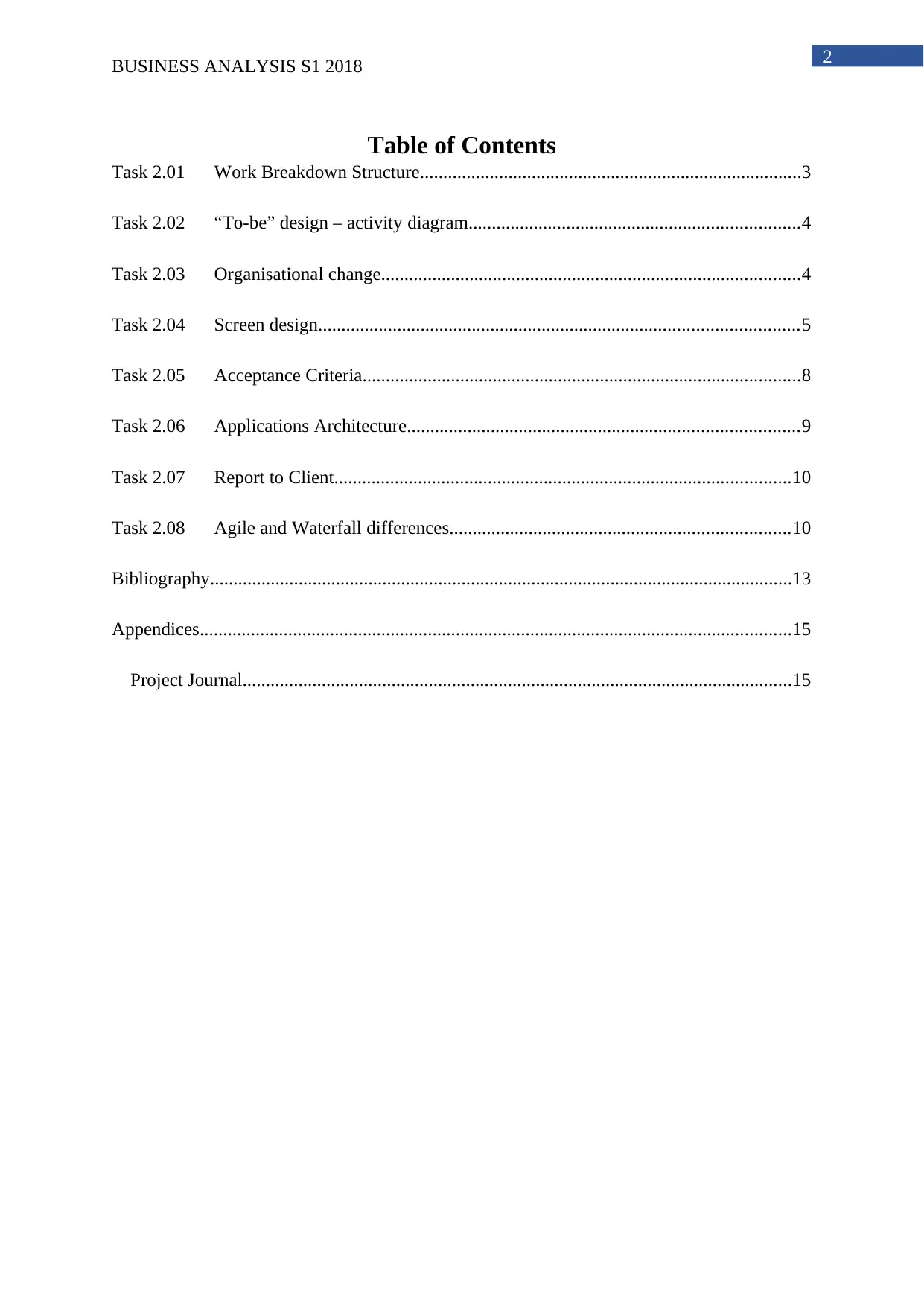
2
BUSINESS ANALYSIS S1 2018
Table of Contents
Task 2.01 Work Breakdown Structure..................................................................................3
Task 2.02 “To-be” design – activity diagram.......................................................................4
Task 2.03 Organisational change..........................................................................................4
Task 2.04 Screen design.......................................................................................................5
Task 2.05 Acceptance Criteria..............................................................................................8
Task 2.06 Applications Architecture....................................................................................9
Task 2.07 Report to Client..................................................................................................10
Task 2.08 Agile and Waterfall differences.........................................................................10
Bibliography.............................................................................................................................13
Appendices...............................................................................................................................15
Project Journal......................................................................................................................15
BUSINESS ANALYSIS S1 2018
Table of Contents
Task 2.01 Work Breakdown Structure..................................................................................3
Task 2.02 “To-be” design – activity diagram.......................................................................4
Task 2.03 Organisational change..........................................................................................4
Task 2.04 Screen design.......................................................................................................5
Task 2.05 Acceptance Criteria..............................................................................................8
Task 2.06 Applications Architecture....................................................................................9
Task 2.07 Report to Client..................................................................................................10
Task 2.08 Agile and Waterfall differences.........................................................................10
Bibliography.............................................................................................................................13
Appendices...............................................................................................................................15
Project Journal......................................................................................................................15
⊘ This is a preview!⊘
Do you want full access?
Subscribe today to unlock all pages.

Trusted by 1+ million students worldwide
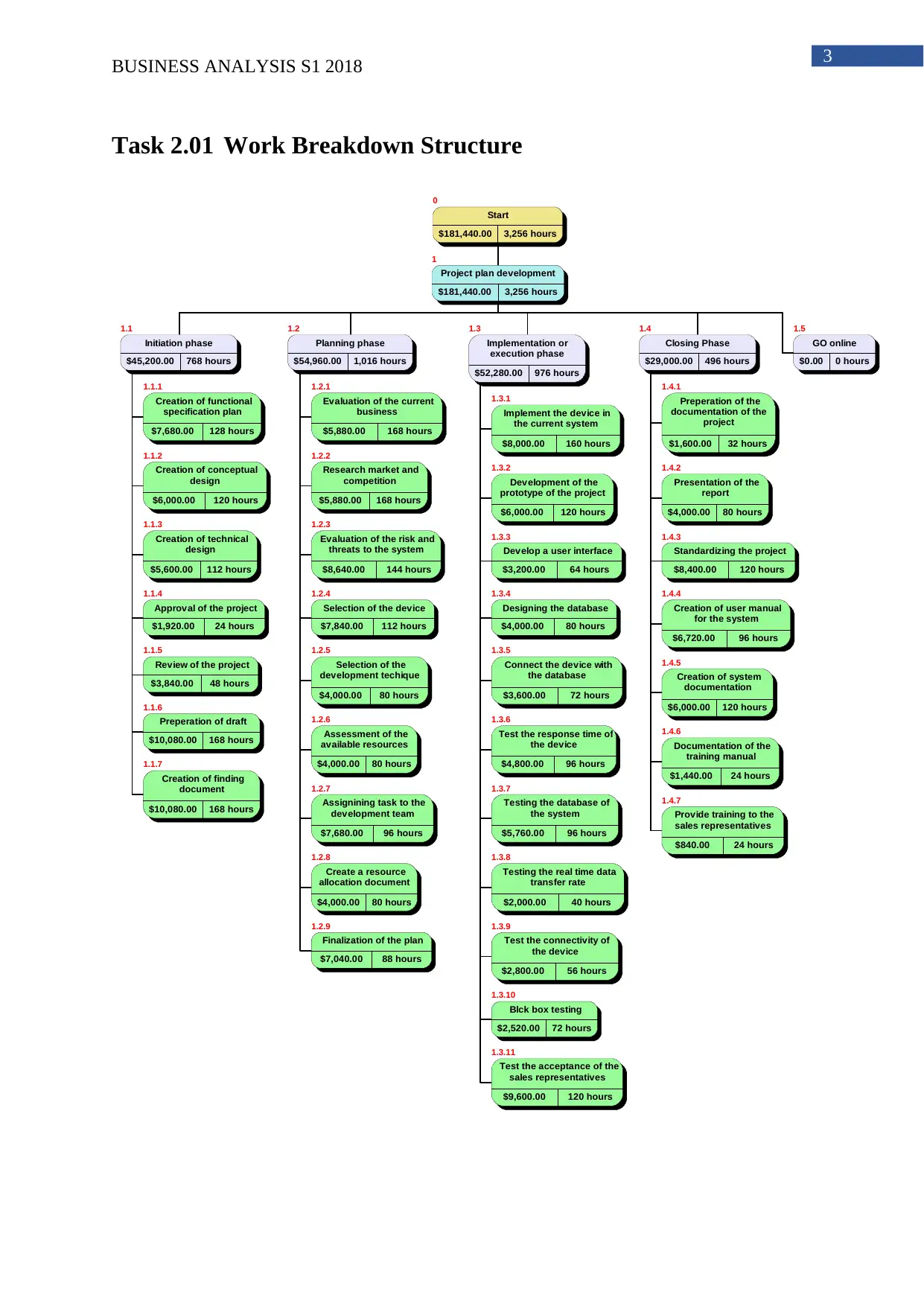
3
BUSINESS ANALYSIS S1 2018
Task 2.01 Work Breakdown Structure
0
1
1.1
1.1.1
1.1.2
1.1.3
1.1.4
1.1.5
1.1.6
1.1.7
1.2
1.2.1
1.2.2
1.2.3
1.2.4
1.2.5
1.2.6
1.2.7
1.2.8
1.2.9
1.3
1.3.1
1.3.2
1.3.3
1.3.4
1.3.5
1.3.6
1.3.7
1.3.8
1.3.9
1.3.10
1.3.11
1.4
1.4.1
1.4.2
1.4.3
1.4.4
1.4.5
1.4.6
1.4.7
1.5
Start
$181,440.00 3,256 hours
Project plan development
$181,440.00 3,256 hours
Initiation phase
$45,200.00 768 hours
Creation of functional
specification plan
$7,680.00 128 hours
Creation of conceptual
design
$6,000.00 120 hours
Creation of technical
design
$5,600.00 112 hours
Approval of the project
$1,920.00 24 hours
Review of the project
$3,840.00 48 hours
Preperation of draft
$10,080.00 168 hours
Creation of finding
document
$10,080.00 168 hours
Planning phase
$54,960.00 1,016 hours
Evaluation of the current
business
$5,880.00 168 hours
Research market and
competition
$5,880.00 168 hours
Evaluation of the risk and
threats to the system
$8,640.00 144 hours
Selection of the device
$7,840.00 112 hours
Selection of the
development techique
$4,000.00 80 hours
Assessment of the
available resources
$4,000.00 80 hours
Assignining task to the
development team
$7,680.00 96 hours
Create a resource
allocation document
$4,000.00 80 hours
Finalization of the plan
$7,040.00 88 hours
Implementation or
execution phase
$52,280.00 976 hours
Implement the device in
the current system
$8,000.00 160 hours
Development of the
prototype of the project
$6,000.00 120 hours
Develop a user interface
$3,200.00 64 hours
Designing the database
$4,000.00 80 hours
Connect the device with
the database
$3,600.00 72 hours
Test the response time of
the device
$4,800.00 96 hours
Testing the database of
the system
$5,760.00 96 hours
Testing the real time data
transfer rate
$2,000.00 40 hours
Test the connectivity of
the device
$2,800.00 56 hours
Blck box testing
$2,520.00 72 hours
Test the acceptance of the
sales representatives
$9,600.00 120 hours
Closing Phase
$29,000.00 496 hours
Preperation of the
documentation of the
project
$1,600.00 32 hours
Presentation of the
report
$4,000.00 80 hours
Standardizing the project
$8,400.00 120 hours
Creation of user manual
for the system
$6,720.00 96 hours
Creation of system
documentation
$6,000.00 120 hours
Documentation of the
training manual
$1,440.00 24 hours
Provide training to the
sales representatives
$840.00 24 hours
GO online
$0.00 0 hours
BUSINESS ANALYSIS S1 2018
Task 2.01 Work Breakdown Structure
0
1
1.1
1.1.1
1.1.2
1.1.3
1.1.4
1.1.5
1.1.6
1.1.7
1.2
1.2.1
1.2.2
1.2.3
1.2.4
1.2.5
1.2.6
1.2.7
1.2.8
1.2.9
1.3
1.3.1
1.3.2
1.3.3
1.3.4
1.3.5
1.3.6
1.3.7
1.3.8
1.3.9
1.3.10
1.3.11
1.4
1.4.1
1.4.2
1.4.3
1.4.4
1.4.5
1.4.6
1.4.7
1.5
Start
$181,440.00 3,256 hours
Project plan development
$181,440.00 3,256 hours
Initiation phase
$45,200.00 768 hours
Creation of functional
specification plan
$7,680.00 128 hours
Creation of conceptual
design
$6,000.00 120 hours
Creation of technical
design
$5,600.00 112 hours
Approval of the project
$1,920.00 24 hours
Review of the project
$3,840.00 48 hours
Preperation of draft
$10,080.00 168 hours
Creation of finding
document
$10,080.00 168 hours
Planning phase
$54,960.00 1,016 hours
Evaluation of the current
business
$5,880.00 168 hours
Research market and
competition
$5,880.00 168 hours
Evaluation of the risk and
threats to the system
$8,640.00 144 hours
Selection of the device
$7,840.00 112 hours
Selection of the
development techique
$4,000.00 80 hours
Assessment of the
available resources
$4,000.00 80 hours
Assignining task to the
development team
$7,680.00 96 hours
Create a resource
allocation document
$4,000.00 80 hours
Finalization of the plan
$7,040.00 88 hours
Implementation or
execution phase
$52,280.00 976 hours
Implement the device in
the current system
$8,000.00 160 hours
Development of the
prototype of the project
$6,000.00 120 hours
Develop a user interface
$3,200.00 64 hours
Designing the database
$4,000.00 80 hours
Connect the device with
the database
$3,600.00 72 hours
Test the response time of
the device
$4,800.00 96 hours
Testing the database of
the system
$5,760.00 96 hours
Testing the real time data
transfer rate
$2,000.00 40 hours
Test the connectivity of
the device
$2,800.00 56 hours
Blck box testing
$2,520.00 72 hours
Test the acceptance of the
sales representatives
$9,600.00 120 hours
Closing Phase
$29,000.00 496 hours
Preperation of the
documentation of the
project
$1,600.00 32 hours
Presentation of the
report
$4,000.00 80 hours
Standardizing the project
$8,400.00 120 hours
Creation of user manual
for the system
$6,720.00 96 hours
Creation of system
documentation
$6,000.00 120 hours
Documentation of the
training manual
$1,440.00 24 hours
Provide training to the
sales representatives
$840.00 24 hours
GO online
$0.00 0 hours
Paraphrase This Document
Need a fresh take? Get an instant paraphrase of this document with our AI Paraphraser
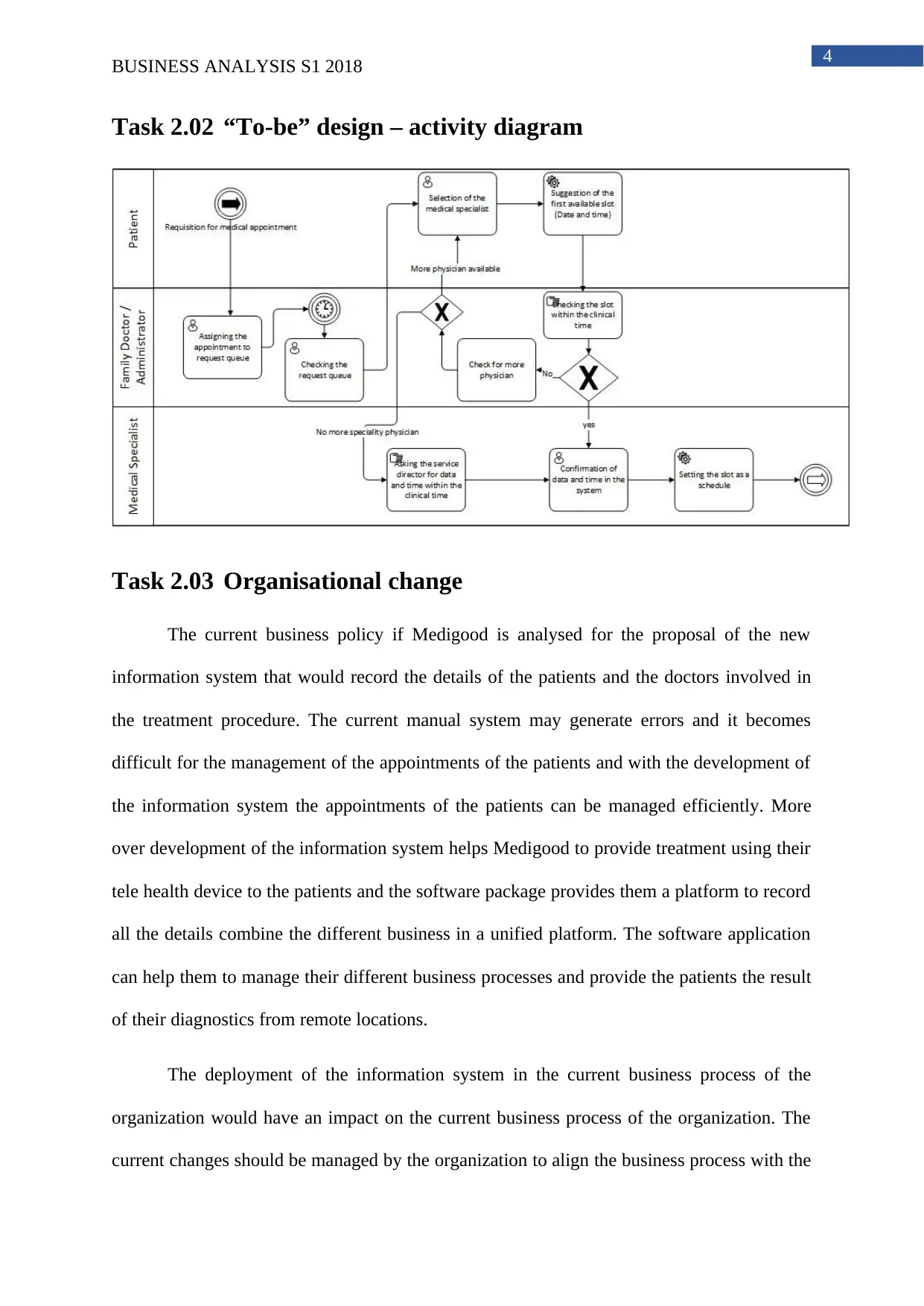
4
BUSINESS ANALYSIS S1 2018
Task 2.02 “To-be” design – activity diagram
Task 2.03 Organisational change
The current business policy if Medigood is analysed for the proposal of the new
information system that would record the details of the patients and the doctors involved in
the treatment procedure. The current manual system may generate errors and it becomes
difficult for the management of the appointments of the patients and with the development of
the information system the appointments of the patients can be managed efficiently. More
over development of the information system helps Medigood to provide treatment using their
tele health device to the patients and the software package provides them a platform to record
all the details combine the different business in a unified platform. The software application
can help them to manage their different business processes and provide the patients the result
of their diagnostics from remote locations.
The deployment of the information system in the current business process of the
organization would have an impact on the current business process of the organization. The
current changes should be managed by the organization to align the business process with the
BUSINESS ANALYSIS S1 2018
Task 2.02 “To-be” design – activity diagram
Task 2.03 Organisational change
The current business policy if Medigood is analysed for the proposal of the new
information system that would record the details of the patients and the doctors involved in
the treatment procedure. The current manual system may generate errors and it becomes
difficult for the management of the appointments of the patients and with the development of
the information system the appointments of the patients can be managed efficiently. More
over development of the information system helps Medigood to provide treatment using their
tele health device to the patients and the software package provides them a platform to record
all the details combine the different business in a unified platform. The software application
can help them to manage their different business processes and provide the patients the result
of their diagnostics from remote locations.
The deployment of the information system in the current business process of the
organization would have an impact on the current business process of the organization. The
current changes should be managed by the organization to align the business process with the
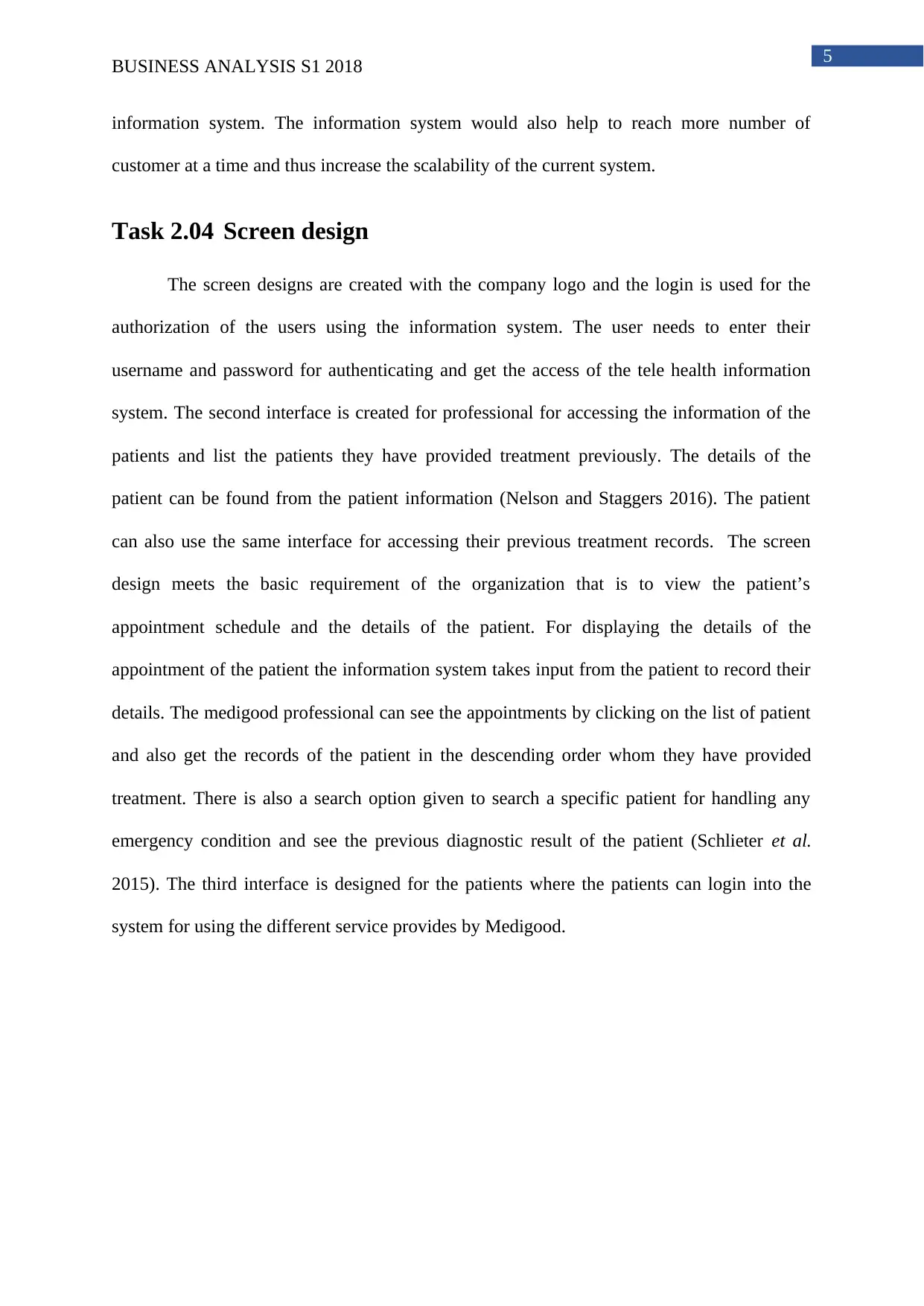
5
BUSINESS ANALYSIS S1 2018
information system. The information system would also help to reach more number of
customer at a time and thus increase the scalability of the current system.
Task 2.04 Screen design
The screen designs are created with the company logo and the login is used for the
authorization of the users using the information system. The user needs to enter their
username and password for authenticating and get the access of the tele health information
system. The second interface is created for professional for accessing the information of the
patients and list the patients they have provided treatment previously. The details of the
patient can be found from the patient information (Nelson and Staggers 2016). The patient
can also use the same interface for accessing their previous treatment records. The screen
design meets the basic requirement of the organization that is to view the patient’s
appointment schedule and the details of the patient. For displaying the details of the
appointment of the patient the information system takes input from the patient to record their
details. The medigood professional can see the appointments by clicking on the list of patient
and also get the records of the patient in the descending order whom they have provided
treatment. There is also a search option given to search a specific patient for handling any
emergency condition and see the previous diagnostic result of the patient (Schlieter et al.
2015). The third interface is designed for the patients where the patients can login into the
system for using the different service provides by Medigood.
BUSINESS ANALYSIS S1 2018
information system. The information system would also help to reach more number of
customer at a time and thus increase the scalability of the current system.
Task 2.04 Screen design
The screen designs are created with the company logo and the login is used for the
authorization of the users using the information system. The user needs to enter their
username and password for authenticating and get the access of the tele health information
system. The second interface is created for professional for accessing the information of the
patients and list the patients they have provided treatment previously. The details of the
patient can be found from the patient information (Nelson and Staggers 2016). The patient
can also use the same interface for accessing their previous treatment records. The screen
design meets the basic requirement of the organization that is to view the patient’s
appointment schedule and the details of the patient. For displaying the details of the
appointment of the patient the information system takes input from the patient to record their
details. The medigood professional can see the appointments by clicking on the list of patient
and also get the records of the patient in the descending order whom they have provided
treatment. There is also a search option given to search a specific patient for handling any
emergency condition and see the previous diagnostic result of the patient (Schlieter et al.
2015). The third interface is designed for the patients where the patients can login into the
system for using the different service provides by Medigood.
⊘ This is a preview!⊘
Do you want full access?
Subscribe today to unlock all pages.

Trusted by 1+ million students worldwide
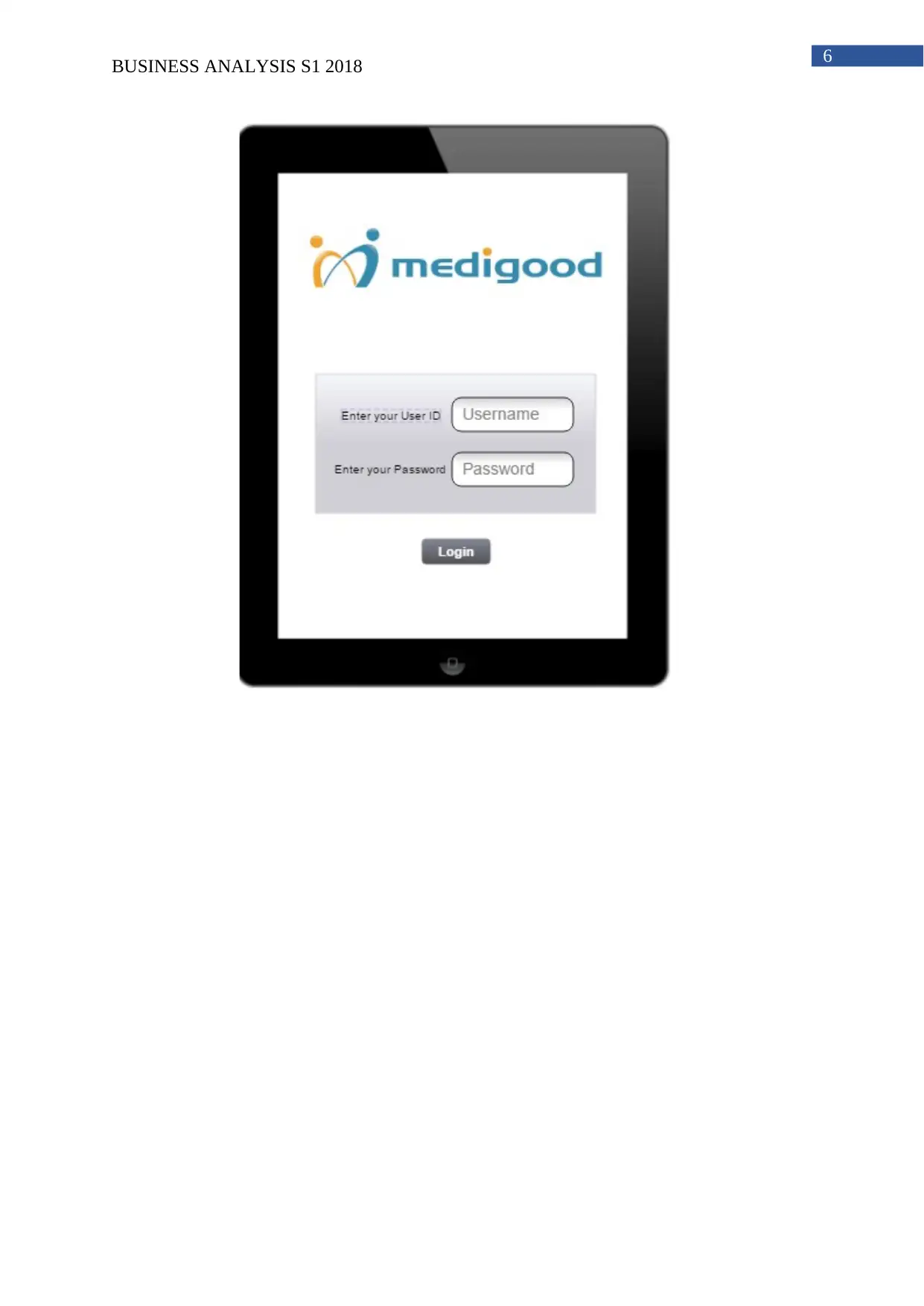
6
BUSINESS ANALYSIS S1 2018
BUSINESS ANALYSIS S1 2018
Paraphrase This Document
Need a fresh take? Get an instant paraphrase of this document with our AI Paraphraser
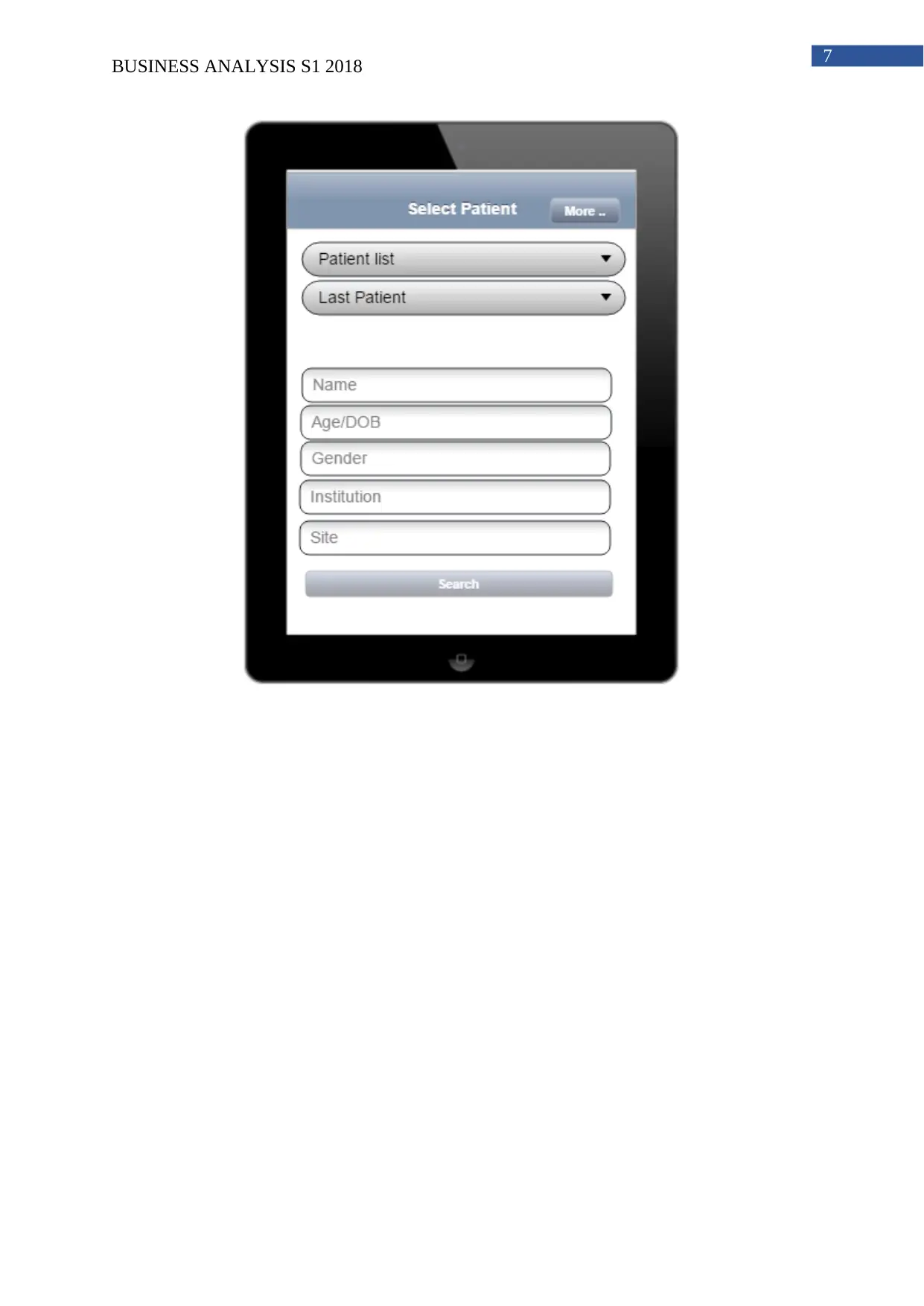
7
BUSINESS ANALYSIS S1 2018
BUSINESS ANALYSIS S1 2018
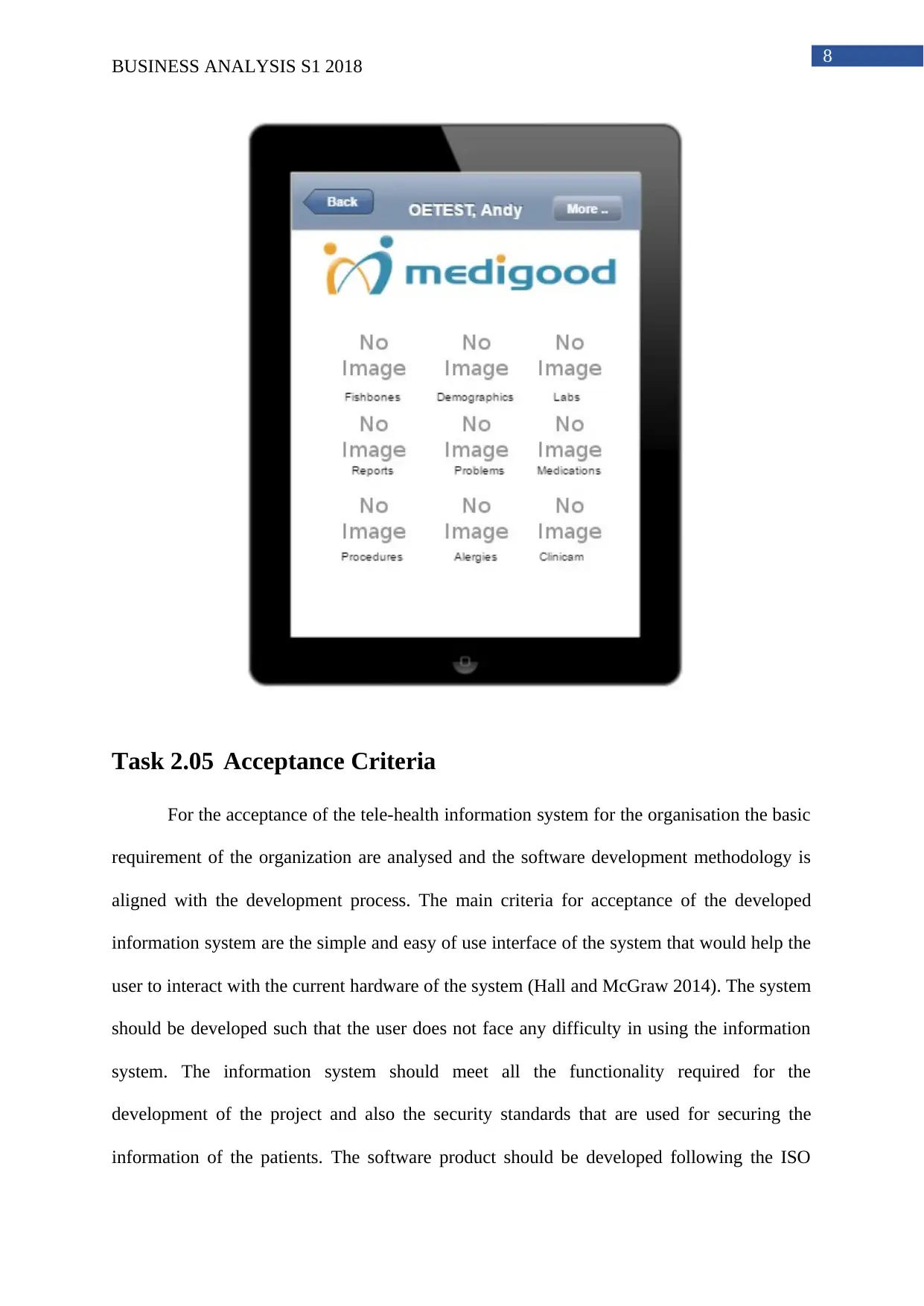
8
BUSINESS ANALYSIS S1 2018
Task 2.05 Acceptance Criteria
For the acceptance of the tele-health information system for the organisation the basic
requirement of the organization are analysed and the software development methodology is
aligned with the development process. The main criteria for acceptance of the developed
information system are the simple and easy of use interface of the system that would help the
user to interact with the current hardware of the system (Hall and McGraw 2014). The system
should be developed such that the user does not face any difficulty in using the information
system. The information system should meet all the functionality required for the
development of the project and also the security standards that are used for securing the
information of the patients. The software product should be developed following the ISO
BUSINESS ANALYSIS S1 2018
Task 2.05 Acceptance Criteria
For the acceptance of the tele-health information system for the organisation the basic
requirement of the organization are analysed and the software development methodology is
aligned with the development process. The main criteria for acceptance of the developed
information system are the simple and easy of use interface of the system that would help the
user to interact with the current hardware of the system (Hall and McGraw 2014). The system
should be developed such that the user does not face any difficulty in using the information
system. The information system should meet all the functionality required for the
development of the project and also the security standards that are used for securing the
information of the patients. The software product should be developed following the ISO
⊘ This is a preview!⊘
Do you want full access?
Subscribe today to unlock all pages.

Trusted by 1+ million students worldwide
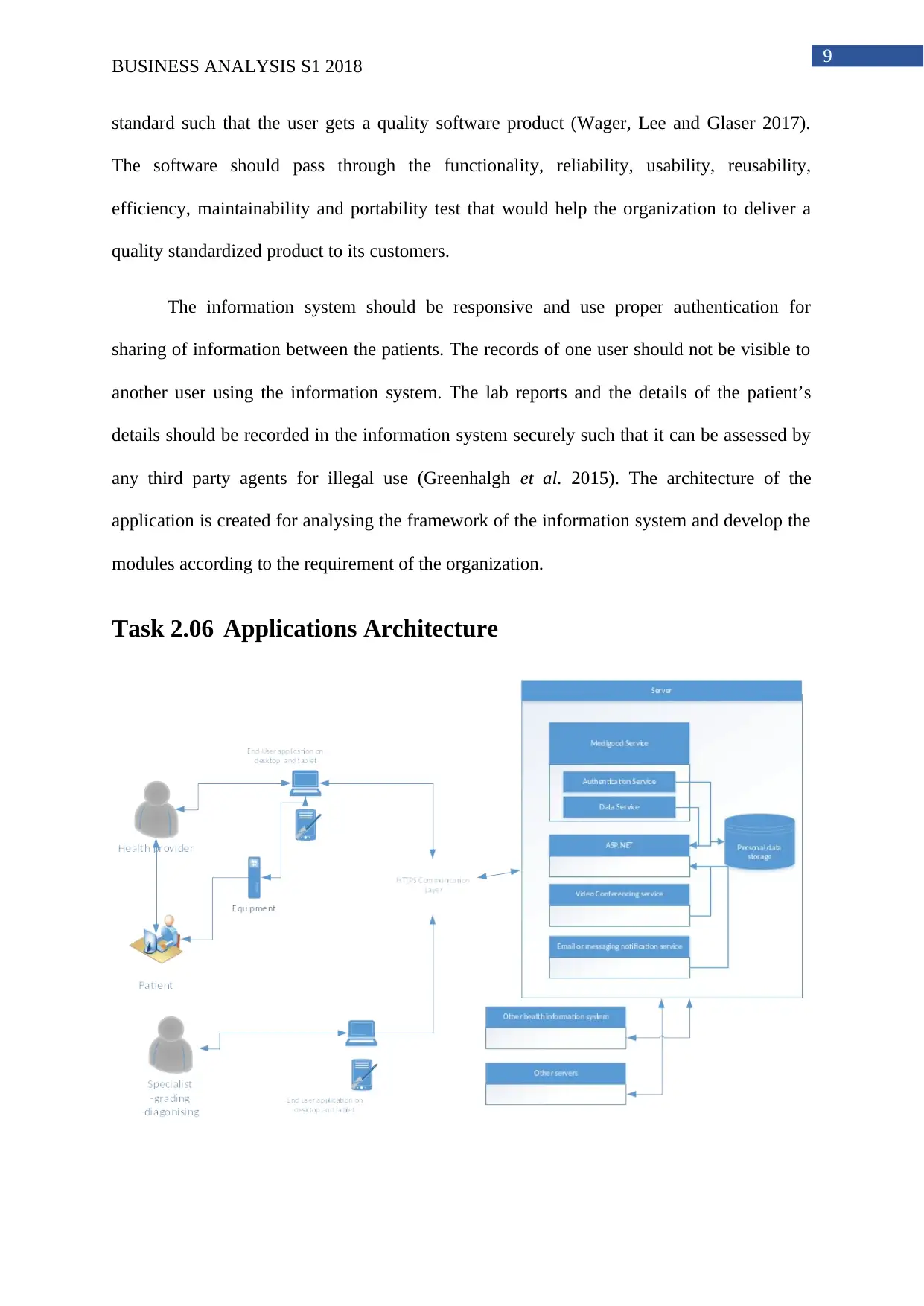
9
BUSINESS ANALYSIS S1 2018
standard such that the user gets a quality software product (Wager, Lee and Glaser 2017).
The software should pass through the functionality, reliability, usability, reusability,
efficiency, maintainability and portability test that would help the organization to deliver a
quality standardized product to its customers.
The information system should be responsive and use proper authentication for
sharing of information between the patients. The records of one user should not be visible to
another user using the information system. The lab reports and the details of the patient’s
details should be recorded in the information system securely such that it can be assessed by
any third party agents for illegal use (Greenhalgh et al. 2015). The architecture of the
application is created for analysing the framework of the information system and develop the
modules according to the requirement of the organization.
Task 2.06 Applications Architecture
BUSINESS ANALYSIS S1 2018
standard such that the user gets a quality software product (Wager, Lee and Glaser 2017).
The software should pass through the functionality, reliability, usability, reusability,
efficiency, maintainability and portability test that would help the organization to deliver a
quality standardized product to its customers.
The information system should be responsive and use proper authentication for
sharing of information between the patients. The records of one user should not be visible to
another user using the information system. The lab reports and the details of the patient’s
details should be recorded in the information system securely such that it can be assessed by
any third party agents for illegal use (Greenhalgh et al. 2015). The architecture of the
application is created for analysing the framework of the information system and develop the
modules according to the requirement of the organization.
Task 2.06 Applications Architecture
Paraphrase This Document
Need a fresh take? Get an instant paraphrase of this document with our AI Paraphraser
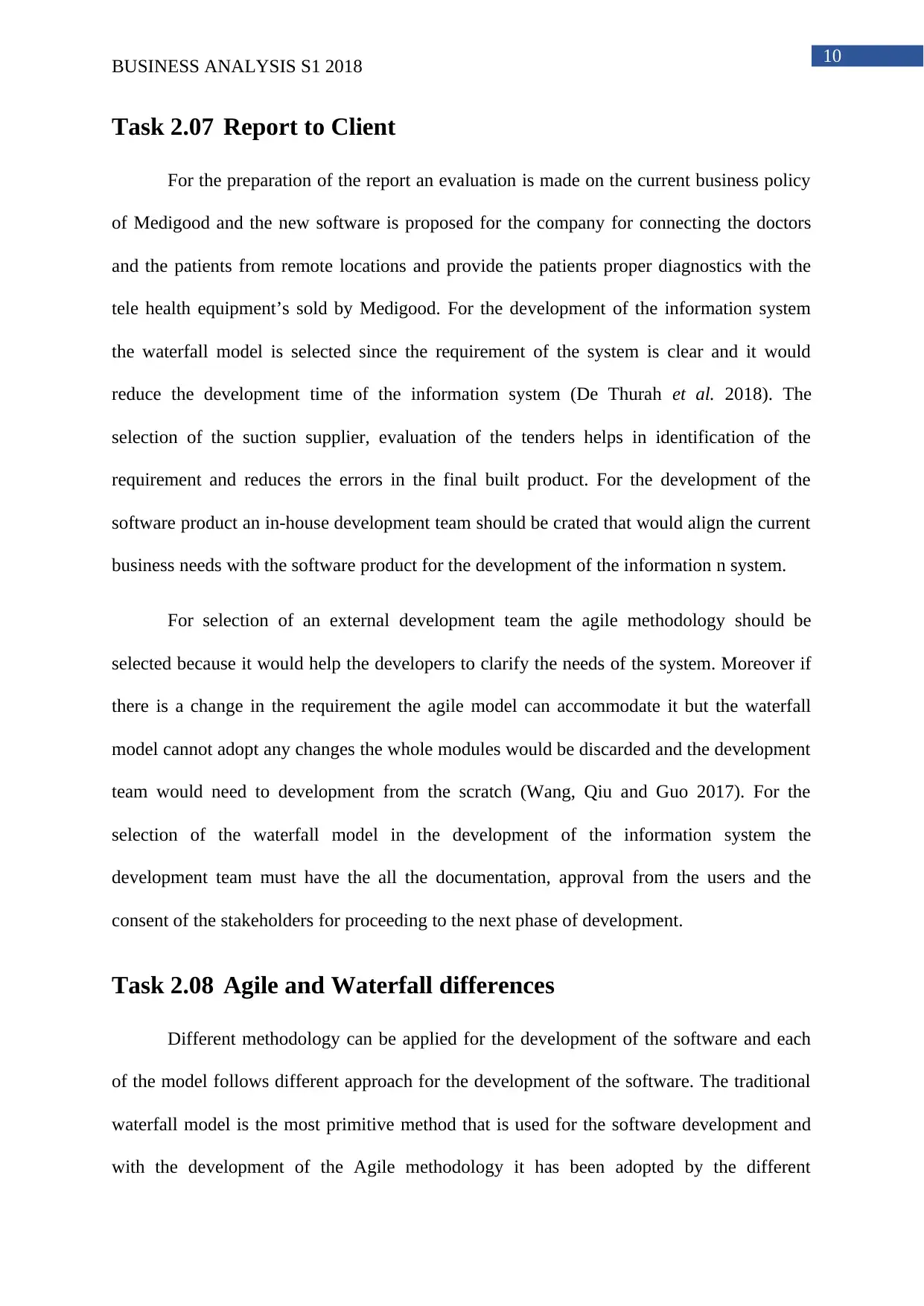
10
BUSINESS ANALYSIS S1 2018
Task 2.07 Report to Client
For the preparation of the report an evaluation is made on the current business policy
of Medigood and the new software is proposed for the company for connecting the doctors
and the patients from remote locations and provide the patients proper diagnostics with the
tele health equipment’s sold by Medigood. For the development of the information system
the waterfall model is selected since the requirement of the system is clear and it would
reduce the development time of the information system (De Thurah et al. 2018). The
selection of the suction supplier, evaluation of the tenders helps in identification of the
requirement and reduces the errors in the final built product. For the development of the
software product an in-house development team should be crated that would align the current
business needs with the software product for the development of the information n system.
For selection of an external development team the agile methodology should be
selected because it would help the developers to clarify the needs of the system. Moreover if
there is a change in the requirement the agile model can accommodate it but the waterfall
model cannot adopt any changes the whole modules would be discarded and the development
team would need to development from the scratch (Wang, Qiu and Guo 2017). For the
selection of the waterfall model in the development of the information system the
development team must have the all the documentation, approval from the users and the
consent of the stakeholders for proceeding to the next phase of development.
Task 2.08 Agile and Waterfall differences
Different methodology can be applied for the development of the software and each
of the model follows different approach for the development of the software. The traditional
waterfall model is the most primitive method that is used for the software development and
with the development of the Agile methodology it has been adopted by the different
BUSINESS ANALYSIS S1 2018
Task 2.07 Report to Client
For the preparation of the report an evaluation is made on the current business policy
of Medigood and the new software is proposed for the company for connecting the doctors
and the patients from remote locations and provide the patients proper diagnostics with the
tele health equipment’s sold by Medigood. For the development of the information system
the waterfall model is selected since the requirement of the system is clear and it would
reduce the development time of the information system (De Thurah et al. 2018). The
selection of the suction supplier, evaluation of the tenders helps in identification of the
requirement and reduces the errors in the final built product. For the development of the
software product an in-house development team should be crated that would align the current
business needs with the software product for the development of the information n system.
For selection of an external development team the agile methodology should be
selected because it would help the developers to clarify the needs of the system. Moreover if
there is a change in the requirement the agile model can accommodate it but the waterfall
model cannot adopt any changes the whole modules would be discarded and the development
team would need to development from the scratch (Wang, Qiu and Guo 2017). For the
selection of the waterfall model in the development of the information system the
development team must have the all the documentation, approval from the users and the
consent of the stakeholders for proceeding to the next phase of development.
Task 2.08 Agile and Waterfall differences
Different methodology can be applied for the development of the software and each
of the model follows different approach for the development of the software. The traditional
waterfall model is the most primitive method that is used for the software development and
with the development of the Agile methodology it has been adopted by the different
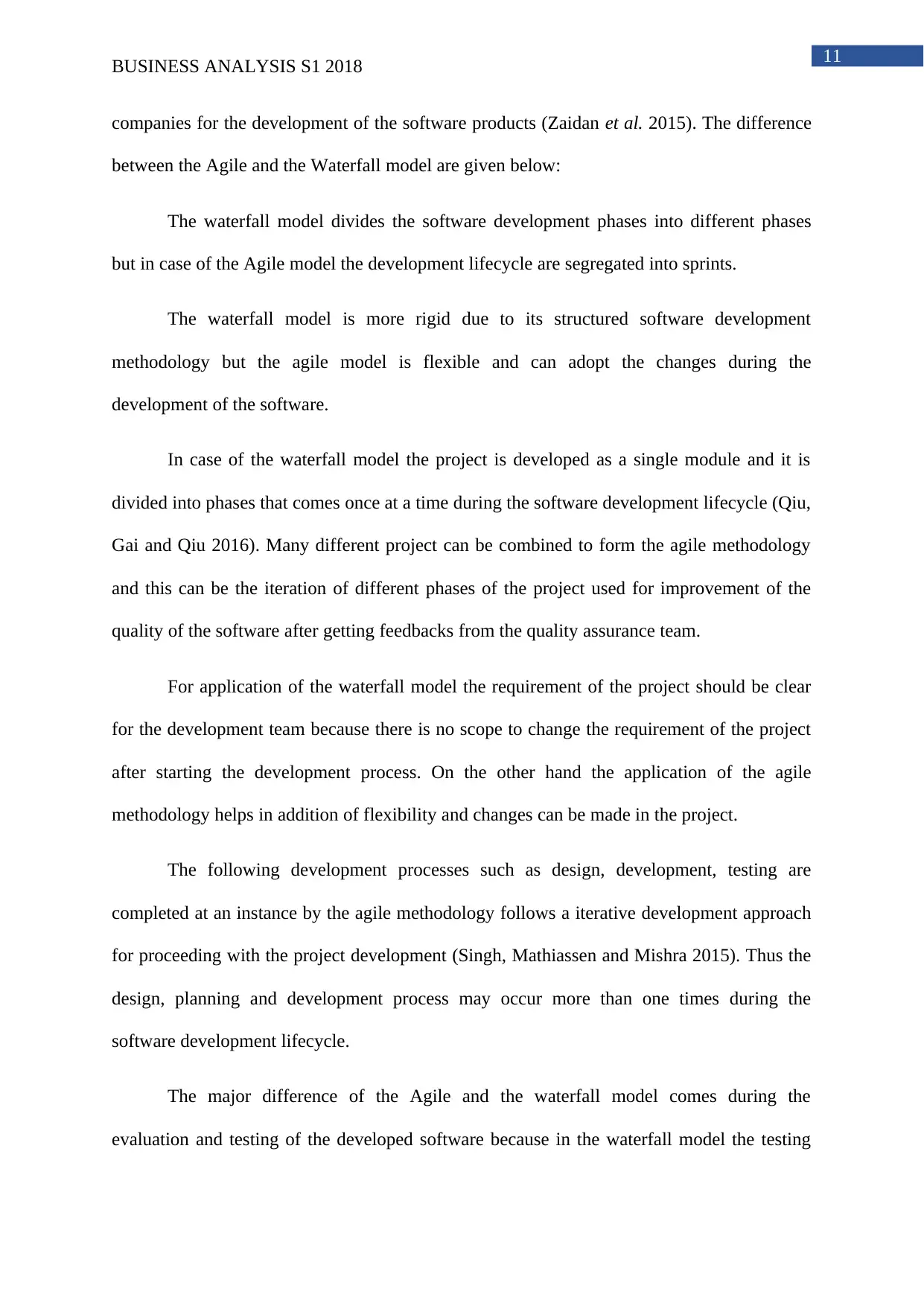
11
BUSINESS ANALYSIS S1 2018
companies for the development of the software products (Zaidan et al. 2015). The difference
between the Agile and the Waterfall model are given below:
The waterfall model divides the software development phases into different phases
but in case of the Agile model the development lifecycle are segregated into sprints.
The waterfall model is more rigid due to its structured software development
methodology but the agile model is flexible and can adopt the changes during the
development of the software.
In case of the waterfall model the project is developed as a single module and it is
divided into phases that comes once at a time during the software development lifecycle (Qiu,
Gai and Qiu 2016). Many different project can be combined to form the agile methodology
and this can be the iteration of different phases of the project used for improvement of the
quality of the software after getting feedbacks from the quality assurance team.
For application of the waterfall model the requirement of the project should be clear
for the development team because there is no scope to change the requirement of the project
after starting the development process. On the other hand the application of the agile
methodology helps in addition of flexibility and changes can be made in the project.
The following development processes such as design, development, testing are
completed at an instance by the agile methodology follows a iterative development approach
for proceeding with the project development (Singh, Mathiassen and Mishra 2015). Thus the
design, planning and development process may occur more than one times during the
software development lifecycle.
The major difference of the Agile and the waterfall model comes during the
evaluation and testing of the developed software because in the waterfall model the testing
BUSINESS ANALYSIS S1 2018
companies for the development of the software products (Zaidan et al. 2015). The difference
between the Agile and the Waterfall model are given below:
The waterfall model divides the software development phases into different phases
but in case of the Agile model the development lifecycle are segregated into sprints.
The waterfall model is more rigid due to its structured software development
methodology but the agile model is flexible and can adopt the changes during the
development of the software.
In case of the waterfall model the project is developed as a single module and it is
divided into phases that comes once at a time during the software development lifecycle (Qiu,
Gai and Qiu 2016). Many different project can be combined to form the agile methodology
and this can be the iteration of different phases of the project used for improvement of the
quality of the software after getting feedbacks from the quality assurance team.
For application of the waterfall model the requirement of the project should be clear
for the development team because there is no scope to change the requirement of the project
after starting the development process. On the other hand the application of the agile
methodology helps in addition of flexibility and changes can be made in the project.
The following development processes such as design, development, testing are
completed at an instance by the agile methodology follows a iterative development approach
for proceeding with the project development (Singh, Mathiassen and Mishra 2015). Thus the
design, planning and development process may occur more than one times during the
software development lifecycle.
The major difference of the Agile and the waterfall model comes during the
evaluation and testing of the developed software because in the waterfall model the testing
⊘ This is a preview!⊘
Do you want full access?
Subscribe today to unlock all pages.

Trusted by 1+ million students worldwide
1 out of 21
Your All-in-One AI-Powered Toolkit for Academic Success.
+13062052269
info@desklib.com
Available 24*7 on WhatsApp / Email
![[object Object]](/_next/static/media/star-bottom.7253800d.svg)
Unlock your academic potential
Copyright © 2020–2025 A2Z Services. All Rights Reserved. Developed and managed by ZUCOL.